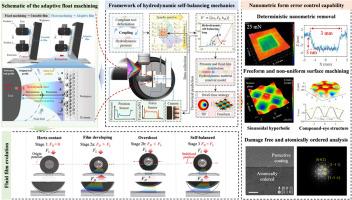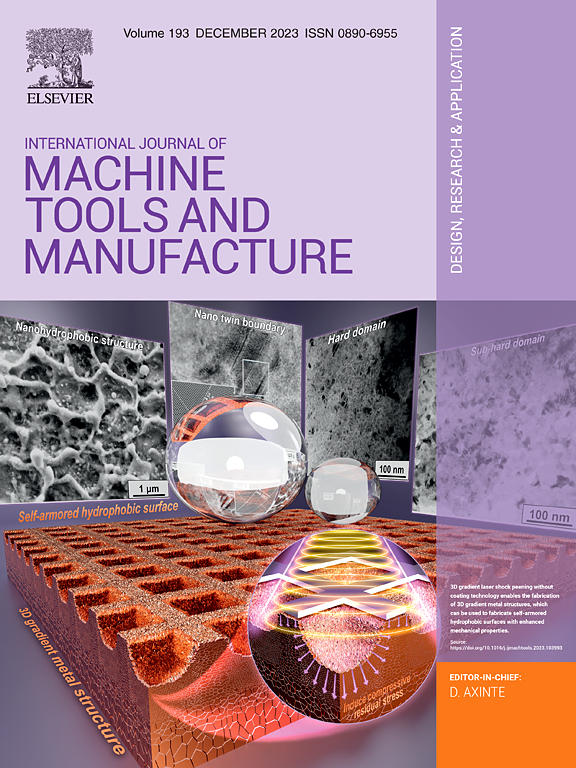Insights into hydrodynamic self-balancing mechanics in adaptive float machining process for nanometric form error control
IF 18.8
1区 工程技术
Q1 ENGINEERING, MANUFACTURING
International Journal of Machine Tools & Manufacture
Pub Date : 2025-09-10
DOI:10.1016/j.ijmachtools.2025.104333
引用次数: 0
Abstract
With advances in semiconductor and aerospace industries, the demand for components with atomic and close-to-atomic scale accuracy is paramount. As a non-contact method, float machining is showing great potential for excellent surface finishing, where the adaptive fluid film between the tool and workpiece plays an essential role. However, its dynamic self-balancing mechanics remains unexplored, without revealing which, the outcome of extreme accuracy could be hardly touched or controlled. To address this issue, a hydrodynamic coupling dataset driven hydrodynamic model with in-situ force-position sensing approach is proposed. This work presents the first systematic elucidation of the transient processes governing the fluid film-tool interaction as the system achieves a balancing state. Simulation and experiments were conducted to demonstrate the adaptive film evolution route, and its relation to the specific process conditions with precise prediction. Insights into the intermediate states and inherent self-balancing mechanism enable exceptional form control ability, namely deterministic removal of 3 nm in depth across an arbitrary 3 mm region. Subsequently, a sinusoidal hyperbolic freeform with form error within ±2 nm PV over a 5 mm region was fabricated using only a stepper-motor platform, and the underlying process produces an atomically ordered, damage-free subsurface. Furthermore, the capability for non-uniform machining was verified by fabricating compound-eye structures and correcting curved surfaces to nanometric form accuracy.

自适应浮子加工过程中纳米形状误差控制的流体动力自平衡力学研究
随着半导体和航空航天工业的进步,对原子和接近原子尺度精度的组件的需求是至关重要的。浮子加工作为一种非接触式加工方法,在实现表面精加工方面显示出巨大的潜力,其中刀具与工件之间的自适应流体膜起着重要的作用。然而,它的动态自平衡机制仍未被探索,没有揭示其中,极端精度的结果几乎无法触摸或控制。为了解决这一问题,提出了一种基于原位力-位置传感方法的水动力耦合数据集驱动的水动力模型。这项工作提出了第一个系统的阐明瞬态过程控制流体膜-工具的相互作用,因为系统达到了平衡状态。通过仿真和实验验证了自适应膜演化路线,并对其与具体工艺条件的关系进行了精确预测。对中间状态和固有的自平衡机制的深入了解使其具有特殊的形状控制能力,即在任意3mm区域内确定去除3nm深度。随后,仅使用步进电机平台就可以在5mm区域内制造出形状误差在±2nm PV内的正弦双曲自由曲面,并且底层工艺产生原子有序,无损伤的亚表面。此外,通过制造复合眼结构和将曲面修正到纳米形状精度,验证了非均匀加工的能力。
本文章由计算机程序翻译,如有差异,请以英文原文为准。
求助全文
约1分钟内获得全文
求助全文
来源期刊
CiteScore
25.70
自引率
10.00%
发文量
66
审稿时长
18 days
期刊介绍:
The International Journal of Machine Tools and Manufacture is dedicated to advancing scientific comprehension of the fundamental mechanics involved in processes and machines utilized in the manufacturing of engineering components. While the primary focus is on metals, the journal also explores applications in composites, ceramics, and other structural or functional materials. The coverage includes a diverse range of topics:
- Essential mechanics of processes involving material removal, accretion, and deformation, encompassing solid, semi-solid, or particulate forms.
- Significant scientific advancements in existing or new processes and machines.
- In-depth characterization of workpiece materials (structure/surfaces) through advanced techniques (e.g., SEM, EDS, TEM, EBSD, AES, Raman spectroscopy) to unveil new phenomenological aspects governing manufacturing processes.
- Tool design, utilization, and comprehensive studies of failure mechanisms.
- Innovative concepts of machine tools, fixtures, and tool holders supported by modeling and demonstrations relevant to manufacturing processes within the journal's scope.
- Novel scientific contributions exploring interactions between the machine tool, control system, software design, and processes.
- Studies elucidating specific mechanisms governing niche processes (e.g., ultra-high precision, nano/atomic level manufacturing with either mechanical or non-mechanical "tools").
- Innovative approaches, underpinned by thorough scientific analysis, addressing emerging or breakthrough processes (e.g., bio-inspired manufacturing) and/or applications (e.g., ultra-high precision optics).

 求助内容:
求助内容: 应助结果提醒方式:
应助结果提醒方式:


